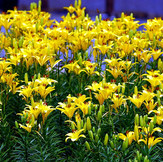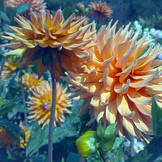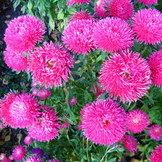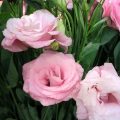These are mono-flowered plants, which can also be calleda one-flower garden. The basis of the flower arrangement of such a flower bed is one genus or species of plants. If, for example, you happened to see a lawn in the garden in the spring, covered with multi-colored primroses, then this was a mono-flower bed. A mono-flower bed of species and varieties of one flower, distinguished by the richness of the color range, is especially picturesque. But there is another approach. In order to highlight and emphasize the beauty of each variety of plant (for example, tulips), they are not mixed, but on the contrary, planted strictly in groups. The area of the garden is divided into several geometrically correct sections, in each of which only one variety is planted: red, white, yellow, pink and white, double, fringed… Such a mono-flower bed is also called a mono-garden. It is often given a rectangular configuration and surrounded by a hedge or trellis.
Lily Garden
- or lilinary, is distinguished by its amazingrefinement and decorativeness from mid-summer to autumn. Perennial flowering lilies have a slender stem, crowned with inflorescences of various shapes from large noble flowers of snow-white, yellowish, reddish with a reddish tint of color, there are forms and varieties with speckled, striped, spotted flowers. Lily bulbs grow over time due to the formation of children, a powerful strong bush develops, bearing up to 50 flowers. Peonies in the garden It is better to plant lilies in a monogardenin separate groups spaced apart from each other against the background of a paddock, whose strict simplicity serves as the best background for bright expressive flowers. Lily plantings also look good against the background of green curtains of shrubs and hedges. The charm of a lily garden is added by their subtle, strong aroma floating above the flowers. However, not all lilies have a scent, and some varieties even have an unpleasant specific smell, for example, monodelphium lilies.
Peonies in the garden It is better to plant lilies in a monogardenin separate groups spaced apart from each other against the background of a paddock, whose strict simplicity serves as the best background for bright expressive flowers. Lily plantings also look good against the background of green curtains of shrubs and hedges. The charm of a lily garden is added by their subtle, strong aroma floating above the flowers. However, not all lilies have a scent, and some varieties even have an unpleasant specific smell, for example, monodelphium lilies.
Peony Garden
- is called pionary.From various varieties of peonies, differing in height, flowering time and color of flowers, you can create a garden of blooming peonies, second only to a rose garden in beauty and aroma. Peony leaves are delicate, ornamental, retain constant decorativeness, after flowering plants are beautiful until late autumn. Peony clumps are located near paths in the form of elongated plantings. The peony garden can be decorated with a hedge of jasmine, red-leaved barberry, lilac, honeysuckle. Sometimes peony plantings can be framed along the perimeter with an outer border of tulips. They bloom earlier than peonies, emphasizing the beauty of their delicate foliage. You can make a second border of annuals, for example, godetia, salvia splendens, marigolds, or late-flowering perennials - astilbe, low-growing phlox. Faded and wilted peony flowers are cut off.
Phlox Garden
…or floxarium, creates an extraordinarybeauty of late summer and early autumn flowering periods. The color, variety of flower and inflorescence shapes make it possible to use a modular distribution of plants, which is consistent with the severity and rectilinearity of the phlox bush shape. Some of the modules can be occupied by a paddock of perennial grasses, some - by a tiled covering. This will allow you to move the modules with plants to places previously occupied by lawn and tiles during transplantation, which will make it possible to diversify the composition of the garden of perennial phloxes for a number of years. The flower composition of the phlox garden can be very diverse due to the richness of the colors of the flowers and the variety of varieties of this magnificent plant.
Dahlia Garden
- called dahlia.It can be single-color, for example red, or multi-colored with a transition from white through fawn, yellow, gold, pink, scarlet, red, burgundy-violet to dark purple. Dahlias in the GardenDahlia Garden Recommendedcreate in a regular style in the form of geometric figures: circle, oval, polygon, square, ellipse, rectangle. Paths with clear lines should be laid inside the garden. Low dahlias with small inflorescences are planted along the edge, then medium-sized and tall dahlias. Supports for tall dahlias should be strong, graceful and inconspicuous. Plantings are made loose, free. It is possible to plant annual seed dahlias along the paths in the form of a border. Alyssum, hosta, pyrethrum and other low-growing plants are also used to create a border in a dahlia. A dahlia can also be in a landscape style.
Dahlias in the GardenDahlia Garden Recommendedcreate in a regular style in the form of geometric figures: circle, oval, polygon, square, ellipse, rectangle. Paths with clear lines should be laid inside the garden. Low dahlias with small inflorescences are planted along the edge, then medium-sized and tall dahlias. Supports for tall dahlias should be strong, graceful and inconspicuous. Plantings are made loose, free. It is possible to plant annual seed dahlias along the paths in the form of a border. Alyssum, hosta, pyrethrum and other low-growing plants are also used to create a border in a dahlia. A dahlia can also be in a landscape style.
Sad gladiolus
- also called gladularium.Gladioli are extremely diverse in color, shape, size of flowers and inflorescences and the whole habit of plants. Gladularia is very suitable for circles of different diameters, next to which a tiled path winds. The circles are united by a lawn, which serves as a background for them. Before planting gladioli, early-flowering annual and biennial flowers, as well as bulbous plants, can be planted in the fall or early spring.
Garden of roses
…or rosary, is perhaps the mosta magnificent type of monogarden. Usually these are purebred plantings of polyanthus roses or floribunda roses, distinguished by abundant and long flowering, bordered by strips of lawn. Tall varieties of roses are surrounded by a border of miniature roses. Standard roses are planted singly or regularly along the rose garden plantings. Climbing roses are used as a complementary element of the rose garden composition for pergolas, arches and special lattices. Color combinations can be varied. In the rose garden composition, roses are given the main dominant role and most of the area. Other plants and the lawn serve only as a background, shading and emphasizing the beauty of the flowers.
Garden of Asters
 …by analogy with the above-described typesmonogardens are called astrariums. Such a garden is created from annual and perennial asters, the flowering of which takes over the beginning of July and continues until the end of October. It is possible to use all the variety of inflorescences with wide-petaled, sharp-needled, twisted petals, simple, semi-double, double forms of different sizes and colors. The richest range of colors and shapes of inflorescences allows you to create numerous monochromatic, contrasting or variegated, "chintz" compositions. In the aster garden, flowers are planted in the form of groups, flower beds, mixborders and astrariums are located in any place of the site so that it looks picturesque.
…by analogy with the above-described typesmonogardens are called astrariums. Such a garden is created from annual and perennial asters, the flowering of which takes over the beginning of July and continues until the end of October. It is possible to use all the variety of inflorescences with wide-petaled, sharp-needled, twisted petals, simple, semi-double, double forms of different sizes and colors. The richest range of colors and shapes of inflorescences allows you to create numerous monochromatic, contrasting or variegated, "chintz" compositions. In the aster garden, flowers are planted in the form of groups, flower beds, mixborders and astrariums are located in any place of the site so that it looks picturesque.
Heather Garden
…or heather is quite popular inRussia. In the genus, represented by several dozen varieties, differing in the color of flowers (from white to dark purple) and foliage (in extreme cases, it can be golden-orange or glaucous-white). In nature, this single species has a colossal range in Europe, stretching from the tundra in the north to the southern border of the coniferous-deciduous forest zone (of all European countries, it is absent only in Italy). In Russia, heathers are especially numerous in the north of the European part, and mainly in dry pine forests, on barren sands and sphagnum bogs - that is, in places with the poorest and most acidic soils. Heathers are valued for their prolonged flowering in the second half of summer. According to the monogarden principle, any other flowering plants can be combined that look spectacular in large quantities and differ in the variety of shapes and colors of flowers, as well as the height and habit of plants. Violets, cyclamens, hydrangeas, rhododendrons, lilacs, jasmine, hyacinth, clematis, tulips - the list of beautiful plants is long, and each has its own army of devoted fans. Therefore, each flower has a chance to one day become the main or even the only decoration of the garden.









